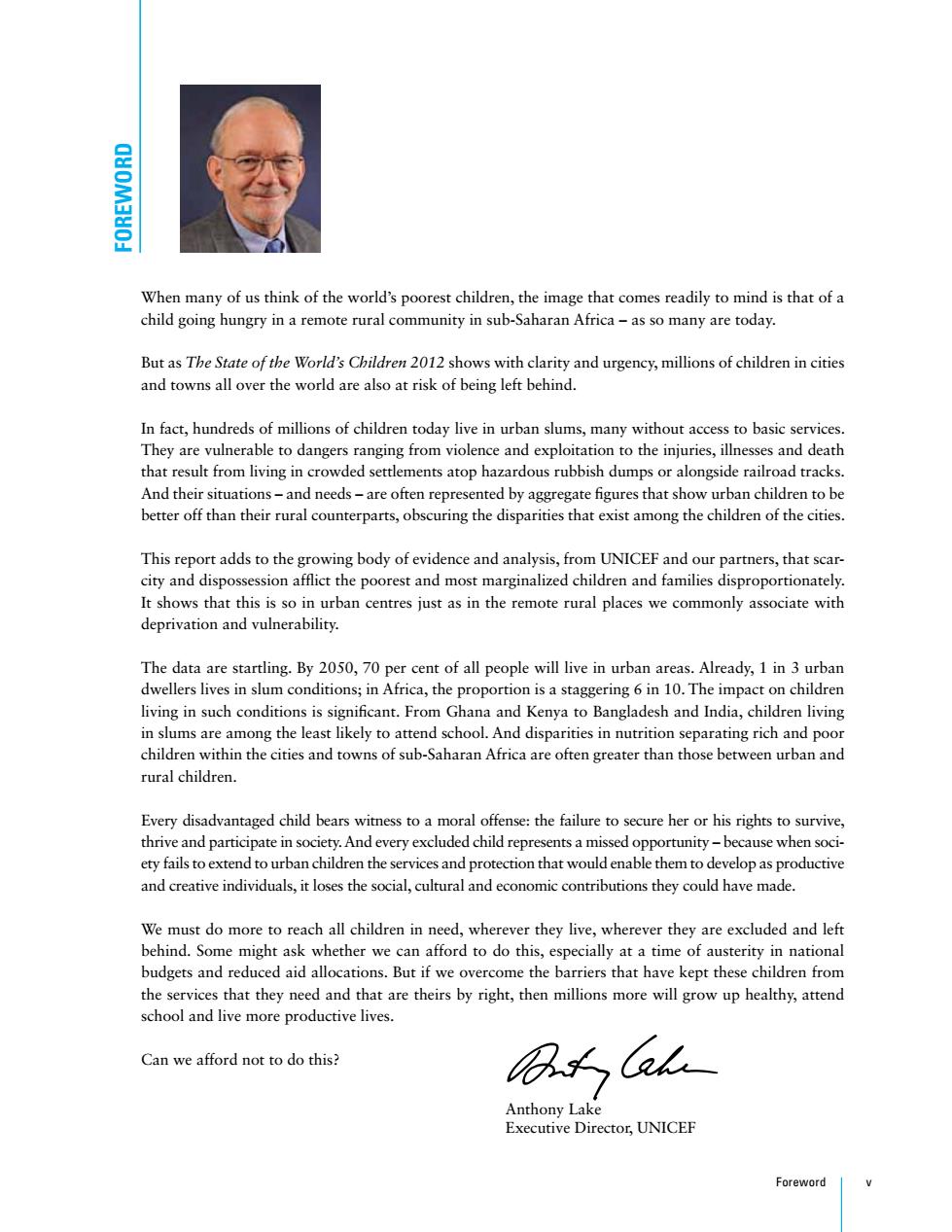正在加载图片...

When many of us think of the world's poorest children,the image that comes readily to mind is that of a child going hungry in a remote rural community in sub-Saharan Africa-as so many are today. But as The State of the World's Children 2012 shows with clarity and urgency,millions of children in cities and towns all over the world are also at risk of being left behind. In fact,hundreds of millions of children today live in urban slums,many without access to basic services. They are vulnerable to dangers ranging from violence and exploitation to the injuries,illnesses and death that result from living in crowded settlements atop hazardous rubbish dumps or alongside railroad tracks. And their situations-and needs-are often represented by aggregate figures that show urban children to be better off than their rural counterparts,obscuring the disparities that exist among the children of the cities This report adds to the growing body of evidence and analysis,from UNICEF and our partners,that scar- city and dispossession afflict the poorest and most marginalized children and families disproportionately. It shows that this is so in urban centres just as in the remote rural places we commonly associate with deprivation and vulnerability. The data are startling.By 2050,70 per cent of all people will live in urban areas.Already,1 in 3 urban dwellers lives in slum conditions;in Africa,the proportion is a staggering 6 in 10.The impact on children living in such conditions is significant.From Ghana and Kenya to Bangladesh and India,children living in slums are among the least likely to attend school.And disparities in nutrition separating rich and poor children within the cities and towns of sub-Saharan Africa are often greater than those between urban and rural children. Every disadvantaged child bears witness to a moral offense:the failure to secure her or his rights to survive, thrive and participate in society.And every excluded child represents a missed opportunity-because when soci- ety fails to extend to urban children the services and protection that would enable them to develop as productive and creative individuals,it loses the social,cultural and economic contributions they could have made. We must do more to reach all children in need,wherever they live,wherever they are excluded and left behind.Some might ask whether we can afford to do this,especially at a time of austerity in national budgets and reduced aid allocations.But if we overcome the barriers that have kept these children from the services that they need and that are theirs by right,then millions more will grow up healthy,attend school and live more productive lives. Can we afford not to do this? Anthony Lake Executive Director,UNICEF ForewordForeword v Anthony Lake Executive Director, UNICEF When many of us think of the world’s poorest children, the image that comes readily to mind is that of a child going hungry in a remote rural community in sub-Saharan Africa – as so many are today. But as The State of the World’s Children 2012 shows with clarity and urgency, millions of children in cities and towns all over the world are also at risk of being left behind. In fact, hundreds of millions of children today live in urban slums, many without access to basic services. They are vulnerable to dangers ranging from violence and exploitation to the injuries, illnesses and death that result from living in crowded settlements atop hazardous rubbish dumps or alongside railroad tracks. And their situations – and needs – are often represented by aggregate figures that show urban children to be better off than their rural counterparts, obscuring the disparities that exist among the children of the cities. This report adds to the growing body of evidence and analysis, from UNICEF and our partners, that scarcity and dispossession afflict the poorest and most marginalized children and families disproportionately. It shows that this is so in urban centres just as in the remote rural places we commonly associate with deprivation and vulnerability. The data are startling. By 2050, 70 per cent of all people will live in urban areas. Already, 1 in 3 urban dwellers lives in slum conditions; in Africa, the proportion is a staggering 6 in 10. The impact on children living in such conditions is significant. From Ghana and Kenya to Bangladesh and India, children living in slums are among the least likely to attend school. And disparities in nutrition separating rich and poor children within the cities and towns of sub-Saharan Africa are often greater than those between urban and rural children. Every disadvantaged child bears witness to a moral offense: the failure to secure her or his rights to survive, thrive and participate in society. And every excluded child represents a missed opportunity – because when society fails to extend to urban children the services and protection that would enable them to develop as productive and creative individuals, it loses the social, cultural and economic contributions they could have made. We must do more to reach all children in need, wherever they live, wherever they are excluded and left behind. Some might ask whether we can afford to do this, especially at a time of austerity in national budgets and reduced aid allocations. But if we overcome the barriers that have kept these children from the services that they need and that are theirs by right, then millions more will grow up healthy, attend school and live more productive lives. Can we afford not to do this? FOREWORD